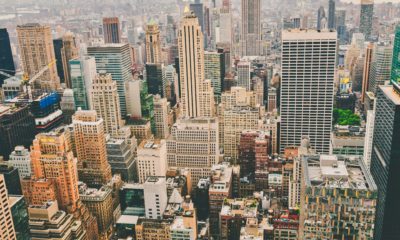Business
The economics of a pandemic
This article restates the obvious in that there are two sides to this coin- health and wealth, risk and reward. No one knows the exact contagion or severity of COVID-19 or how to eradicate it. Prolonging the shutdown of the world’s greatest economy may or may not guarantee an improvement of the associated death rate harming less than 1% of the population, but it will guarantee an economic disaster.

On Sunday afternoon, I took my teenage boys on a long bike ride to enjoy some fresh air and break from the quarantine. Apparently, everyone else at the Jersey Shore had the same idea, and didn’t mind walking, pedaling, or jogging within six feet of each other. I mentioned to a cop buddy of mine that our local pizzeria was slammed, the small storefront served patrons coming and going. He said they should be shut down. I replied they’re a true Mom n Pop shop that could either hustle to pay rent, keep the business afloat, and put food on the table for their family or very likely go belly up. “Not my problem”, he replied, easily said with an uninterrupted paycheck, benefits, and a free $1,200 check in hand.
As Americans grow increasingly tired by a government mandated economic shutdown, more of these differences are sure to arise. It’s the result of a capitalistic economy and free society merging with public safety. In classic political fashion to never let a good crisis go to waste, more of these debates will become politicized.
Three metrics can provide a frame of reference- Severity (degree of impact to the affected), Magnitude (degree of impact to the general population), and Speed (length of time before affected realizes severity). The current equation contains an evolving problem in coronavirus with undetermined magnitude (see Mass General’s random test of 200 residents showing 64 COVID-19 positives), moving severity (death rates change as more testing continues), and fast onset within days of contraction as figures total roughly 814,000 identified cases and 44,000 deaths in USA (as of 4/20/2020). There are several possible public restraints, all with an array of consequences. History can offer several case studies for conjecture…
Cigarettes
- Problem- (Severity- high, Magnitude- high, Speed- slow) Cancer and related health issues.
- According to the Centers for Disease Control (CDC), smoking is responsible for more than 480,000 deaths per year in the US, including over 41,000 deaths resulting from secondhand smoke exposure. This accounts for nearly one in five deaths annually.
- Government Reaction- (Moderate) Limit Smoking.
- 28 states have comprehensive smoke-free laws, but none ban smoking in the workplace. Food and Drug Administration has banned flavored E-cigarettes targeted towards youth.
- Economic Impact- (High)
- In the liability column, the total economic cost of smoking is an estimated $300 billion per year, including $170 billion in direct medical care for adults. In the asset column, states collected $27.3 billion in tax revenue and court settlements.
Cars
- Problem- (Severity- varies, Magnitude- high, Speed- fast) Motor Vehicle Accidents.
- Between 1913 and 2018, the number of motor-vehicle related deaths in America increased 838% from 4,200 in 1913 to 39,404 in 2018. However, there were 2 million licensed drivers then versus 227 million today. The vehicle death rate reached its peak in 1937 with 30.8 deaths per 100,000 population versus the current rate of 12.0 per 100,000, representing a 61% improvement. Speeding was a factor in 26% of all traffic fatalities.
- Government Reaction- (High) State and local laws on seat belts, speeding, and driving while intoxicated.
- Volvo design engineer, Nils Bohlin, patented the first 3-point safety belt in 1958. In 1984 New York became the first state to mandate that drivers use a seat belt. Over the next eleven years 48 other states implemented seat belt laws. New Hampshire remains the only state without a seat belt use law. Seat belts and other car safety features led the drastic improvements since the 1980’s.
- Economic Impact- (High)
- USA is the second largest market for vehicle sales and production. Since Honda opened its first US plant in 1982, almost every major foreign automaker has produced vehicles and invested over $75 billion in America. US affiliates of foreign owned companies support 400,000 American jobs and a $114.6 billion domestic sector of the economy. This does not include the overall value of transportation to every industry.
Swimming
- Problem- (Severity- high, Magnitude- low, Speed- fast) Drowning.
- According to CDC, there are an average of 3,536 fatal drownings annually in the United States. Drowning accounts for more deaths of children ages one to four years-old than any other cause besides congenital anomalies.
- Government Reaction- (Low)
- “Swim at Your Own Risk” signs at some municipalities’ beaches. Suggested, but not mandated swim courses for youth, safety vests, CPR, and fence enclosed pools.
- Economic Impact- (Low)
- According to Office for Coastal Management there are 154,000 beach related businesses employing 3.3 million people and generating over $304 billion of GDP. There are an additional 10.4 million residential pools and 309,000 public swimming sites in the US.
Alcohol
- Problem- (Severity- varies, Magnitude- high, Speed- varies) Health and crime.
- An estimated 88,000 people die annually from alcohol related deaths.
- Government Solution- (High) At one point, outright prohibition of liquor.
- The Volstead Act created a nationwide constitutional ban on importation, production, transportation, and sale of alcohol from 1920-1933, coined the “National Experiment”, by President Hoover. In 1933, the 21st Amendment was the only time in history an amendment was passed to repeal another, the 18th.
- Economic Impact- (High)
- The closing of breweries, distilleries, and saloons triggered thousands of direct job losses and exponentially more indirectly through barrel makers, truckers, waiters, etc. States previously relied heavily upon excise taxes from liquor, in NY accounting for almost 75% of its revenue. It cost the federal government over $11 billion in revenue and over $300 million to enforce with 1,520 prohibition police. By 1930 an estimated 100,000 speakeasies existed in NYC, leading to the reputed rise of the mob in America via Al Capone and other criminals. A 2015 study estimated the repeal of prohibition had a net social benefit of “$432 million per annum in 1934–1937, about 0.33% of gross domestic product. Total benefits of $3.25 billion consist primarily of increased consumer and producer surplus, tax revenues, and reduced criminal violence costs”.
Polio
- Problem- (Severity- varies, Magnitude- moderate, Speed- moderate) Highly contagious and paralyzing illness.
- From 1916 to 1954 poliomyelitis plagued Americans, particularly children and young adults every summer. The disease paralyzed 1-2% of those infected, including President Franklin D. Roosevelt.
- Government Reaction- (Moderate) Social Distancing
- Avoiding pools and social gatherings during outbreaks, including government-imposed household and township wide quarantines. The Salk vaccine was eventually developed in 1954. The last polio case in US was in 1979.
- Economic Impact- (Varies)
- Most reports show localized impact based more upon fear of social gathering than government mandated restrictions.
Spanish flu of 1918
- Problem- (Severity- high, Magnitude- high, Speed- fast) Highly contagious illness.
- The Spanish flu killed an estimated 675,000 Americans and over 20 to 50 million people worldwide while infecting over 1/3 of the world’s population.
- Government Reaction- (Moderate to High) Social Distancing based on state and city.
- Philadelphia continued to host a parade in the middle of the flu, whereas the health commissioner of St. Louis, Dr. Max Starkloff, flattened the curve with a strict quarantine that resulted in 1/8th the death rate of Philly.
- Economic Impact- (High)
- Employee wages increased as the work supply was lowered by such a dramatic drop in population. The flu eventually disappeared before it was ever contained.
The point of this article restates the obvious in that there are two sides to this coin- health and wealth, risk, and reward. No one knows for certain the exact contagion or severity of COVID-19 or how to eradicate it. Prolonging the shutdown of the world’s greatest economy may or may not guarantee an improvement of the associated death rate harming less than 1% of the population, but it will guarantee an economic disaster affecting 100% of the population.
Oil prices have plummeted over 90% in 2020 with international travel bans and quarantines possibly prompting catastrophic credit defaults. Financial experts worry if the $2.2 trillion bridge loan provided by the CARES Act will prevent a deepened recession. As 0.2% of the US population has been confirmed infected and .01% deceased (concentrated towards elderly and those with health issues), the debate will continue over how to fix the health and wealth of America. Pundits will argue that traffic fatalities, lung cancer, drowning, and alcohol-related diseases can all simply be reduced from their extraordinary numbers to zero, but we continue to build highways, produce cigarettes, enjoy the beaches, and sip a beer, arguing that the majority outweigh the minority. Others will point to the Spanish Flu’s destruction across the globe, granted most infected suffered its symptoms whereas coronavirus often goes undetected.
There is only so long the government can control a free people. In the fall of 1929, ten years after alcohol was outlawed, the Mayor of Berlin, Gustav Boess, visited New York City and walked away asking NYC Mayor James J. Walker when Prohibition was meant to go into effect. That overwhelming defiance was for the right to have a drink, now we are talking about people’s right to work and feed their families. As some states elect to reopen next month, time will reveal if such ambitions came all too soon.
—
(Featured image by NickyPe via Pixabay)
DISCLAIMER: This article was written by a third party contributor and does not reflect the opinion of Born2Invest, its management, staff or its associates. Please review our disclaimer for more information.
This article may include forward-looking statements. These forward-looking statements generally are identified by the words “believe,” “project,” “estimate,” “become,” “plan,” “will,” and similar expressions. These forward-looking statements involve known and unknown risks as well as uncertainties, including those discussed in the following cautionary statements and elsewhere in this article and on this site. Although the Company may believe that its expectations are based on reasonable assumptions, the actual results that the Company may achieve may differ materially from any forward-looking statements, which reflect the opinions of the management of the Company only as of the date hereof. Additionally, please make sure to read these important disclosures.

-

 Impact Investing1 week ago
Impact Investing1 week agoVernazza Autogru Secures €5M Green Loan to Drive Sustainable Innovation in Heavy Transport
-

 Markets4 days ago
Markets4 days agoRice Market Slips Amid USDA Revisions and Quality Concerns
-

 Business2 weeks ago
Business2 weeks agoLegal Process for Dividing Real Estate Inheritance
-

 Fintech13 hours ago
Fintech13 hours agoJPMorgan’s Data Fees Shake Fintech: PayPal Takes a Hit
























